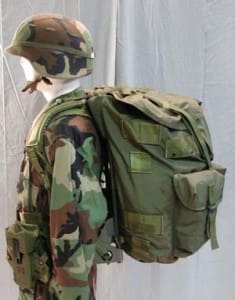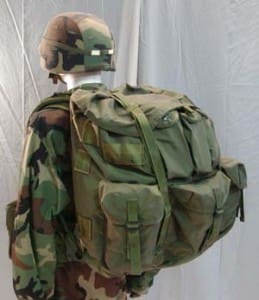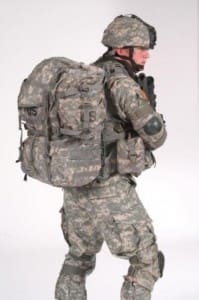 Military.com’s Defense Tech Blog just published a teaser for an article on a new “Medium” pack for use in Afghanistan. The intent is to provide a pack that fits somewhere in between the current 2000 cubic inch Assault Pack and the 5000 cubic inch Modular Lightweight Load carrying Equipment (MOLLE) Rucksack. Interestingly, the initial variant of the current MOLLE pack was of Medium size and only after a couple of years did the Army change out to the current Large pack.
Military.com’s Defense Tech Blog just published a teaser for an article on a new “Medium” pack for use in Afghanistan. The intent is to provide a pack that fits somewhere in between the current 2000 cubic inch Assault Pack and the 5000 cubic inch Modular Lightweight Load carrying Equipment (MOLLE) Rucksack. Interestingly, the initial variant of the current MOLLE pack was of Medium size and only after a couple of years did the Army change out to the current Large pack. In fact, the Large MOLLE ruck was only developed to support light forces like the 10th Mountain Division and there was a great deal of hand wringing over whether it would be appropriate to replace the Medium on general issue. It can be denoted from the earlier version by the addition of a halfmoon zippered compartment on the bottom which is used to carry the sleep system rather than a separate bag.
In fact, the Large MOLLE ruck was only developed to support light forces like the 10th Mountain Division and there was a great deal of hand wringing over whether it would be appropriate to replace the Medium on general issue. It can be denoted from the earlier version by the addition of a halfmoon zippered compartment on the bottom which is used to carry the sleep system rather than a separate bag.
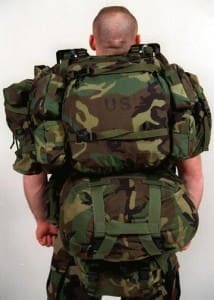 As you can see from this photo (actually an early medical version issued to Navy Corpsman supporting the Marines), the original pack was much smaller but fell in line with the modularity of the overall system. It could be used in conjunction with a variety of additional options including the side mounted sustainment pouches as well as the sleeping bag carrier. Later, with the advent of the Ranger variant of MOLLE a waist pack was added to the mix. When MOLLE was initially envisioned the concept was to provide a variety of modules that the user could add or subtract in order to mission tailor the load. There was concern about devloping a pack that could overload the wearer.
As you can see from this photo (actually an early medical version issued to Navy Corpsman supporting the Marines), the original pack was much smaller but fell in line with the modularity of the overall system. It could be used in conjunction with a variety of additional options including the side mounted sustainment pouches as well as the sleeping bag carrier. Later, with the advent of the Ranger variant of MOLLE a waist pack was added to the mix. When MOLLE was initially envisioned the concept was to provide a variety of modules that the user could add or subtract in order to mission tailor the load. There was concern about devloping a pack that could overload the wearer.
The US military used the All-purpose Individual Lightweight Carrying Equipment (ALICE) system up until the late 1990s which included medium as well as large packs. Both fit on a tubular metal frame so the concept of offering several pack options is nothing new. It seems that more and more often, the Army is learning that the Soldier needs several options in his “toolbox”. For example, SOCOM selected an entire suite of pack sizes for their troops.
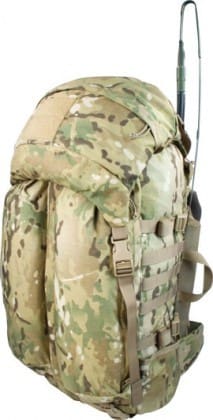 One possible solution is the Mystery Ranch SATL which is issued to SOCOM and integrates MR’s proprietary Bolster Ventilation and Stability (BVS) system which was designed to increase the stability of the pack over body armor. Consider the SATL a daypack on steroids with external pockets to help compartmentalize gear. Its internal frame design helps stabilize teh load yet keep the pack’s weight to a minimum.
One possible solution is the Mystery Ranch SATL which is issued to SOCOM and integrates MR’s proprietary Bolster Ventilation and Stability (BVS) system which was designed to increase the stability of the pack over body armor. Consider the SATL a daypack on steroids with external pockets to help compartmentalize gear. Its internal frame design helps stabilize teh load yet keep the pack’s weight to a minimum.
As you can see, over time the US has provided multiple pack sizes to its troops. It will be interesting to see how this “new” requirement pans out; whether it is an internal frame, external frame, or a frameless pack and whether it will be adopted into the MOLLE program of record.
Tags: MOLLE


